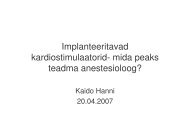The PiCCO system The PiCCO system
The PiCCO system The PiCCO system
The PiCCO system The PiCCO system
You also want an ePaper? Increase the reach of your titles
YUMPU automatically turns print PDFs into web optimized ePapers that Google loves.
<strong>The</strong> PiCClin Study<br />
A Perel, M Maggiorini, M Malbrain, JL Teboul, J Belda,<br />
E Fernández-Mondéjar, M Kirov, J Wendon<br />
<strong>The</strong> patient population included 206 patients,<br />
which were evaluated by 166 residents and 146<br />
specialists (total of 315 questionnaires).<br />
Participants i t were asked to predict advanced<br />
d<br />
hemodynamic parameters and decide on a<br />
therapeutic plan prior to <strong>PiCCO</strong> insertion.<br />
<strong>The</strong> PiCClin Study<br />
A Perel, M Maggiorini, M Malbrain, JL Teboul, J Belda,<br />
E Fernández-Mondéjar, M Kirov, J Wendon<br />
<strong>The</strong> main reasons for using the <strong>PiCCO</strong><br />
monitoring <strong>system</strong> included:<br />
‣ Unclear fluid status (136)<br />
‣ Suspected sepsis / septic shock (89)<br />
‣ Respiratory failure (59)<br />
‣ Cardiogenic shock (24)<br />
‣ Renal failure (32)<br />
‣ Other (21)<br />
18
















